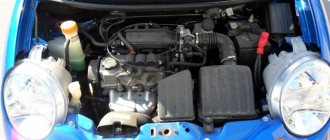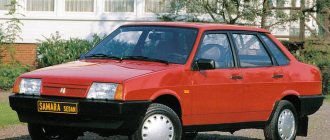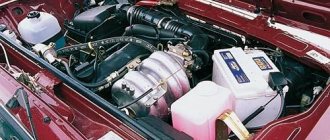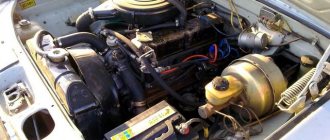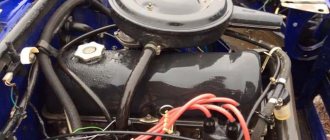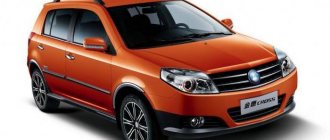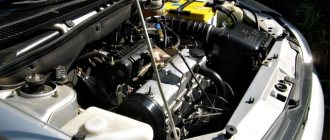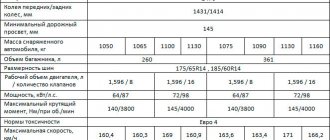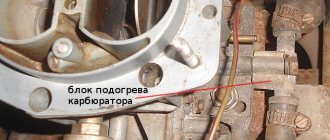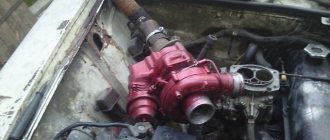Reworking the 2115 engine - reasons and difficulties
Generally speaking, replacing the motor is an undesirable procedure. The reason lies in the fact that the engine installed at the factory is the most optimal for this particular car - everything has already been thought out by the designers and engineers. True, the results obtained do not always satisfy motorists.
So, it’s worth comparing at least the total resource of domestic and foreign engines. For the first (specifically for the VAZ 2115) it is 250,000 kilometers, and for the second (similar in all other parameters) - 500,000 kilometers. Even this fact alone makes drivers think about installing an engine from a foreign car in a VAZ 2115.
It should be remembered that the problem of installing and altering the engine is not the only one that will have to be faced. Most drivers are not stopped by it, but by the enormous difficulties of further registering such a modified car with the traffic police.
Speaking about the choice of engine, we can answer very briefly - you can install absolutely any engine that fits in the engine compartment. True, in most cases, a bunch of other mechanisms will have to be replaced, as a result of which little will remain of the original car (except for the body and interior).
That is why you should give preference to the most compatible engines. Another, no less optimal option is to upgrade the original engine. It will be much cheaper and will not cause any problems with the police.
Simple and reliable way out
You don’t have to go far and reinvent the wheel - you can use what your local manufacturer offers.
Any engine from the classics - VAZ 21011, 2103, 2106
and even from 2113 it will be worth a penny without any problems. The fasteners are identical for all, minimal modifications will be required. The main advantage of the solution: the engine can be installed almost new, while from foreign cars you will get ones that are already well-worn. (see article “Replacing the engine with a contract one”).
For more modern models (VAZ 2108-2170), it will be necessary to cut the body and think through the fastenings, although even here there will not be so much hassle.
Niva 1.7 will give good power. Only here you need to be careful and install the new engine with the original oil pump and sump: in the Niva they hang lower, and when installed on a “penny” there is a high probability of snags.
Motor VAZ-21126
from Lada Priora is also a good solution. With a volume of 1.6 liters. and a power of 98 horses, the VAZ 2101 will run like a young one.
It’s especially nice that you don’t have to change the box - all gearboxes can be easily connected to the new engine.
Engine dismantling process
Of course, the best option would be to replace the engine in a fully equipped workshop, but if this is not possible (and you really want to do tuning), then you should have the following minimum set of equipment:
- winch, hoist or hydraulic lift;
- shoes;
- jacks;
- cart;
- knob with a set of heads;
- spanners;
- screwdrivers.
Dismantling is carried out in the following order:
- The car is stopped using a hand brake and shoes, which should be placed under the rear wheels.
- Place the front wheels on jacks.
- With the hood open, disconnect the “mass” terminal and all small hoses and tubes suitable for the engine.
- Seal the pipe inlets to the engine to prevent them from clogging.
- Disconnect the throttle cable from the throttle pipe and bracket.
- Disconnect the air intake hose together with its bracket.
- To dismantle the air filter - to do this, use a sharp blade to cut off the three rubberized supports, due to which it is attached to the engine body.
- Remove the hoses leading to the receiver.
- Disconnect the hose intended for purging the adsorber from the nozzle.
- Remove the wires suitable for the pipe, the ignition module, as well as all others connected to the internal combustion engine.
- Remove the engine splash guard by unscrewing the mounting bolts.
- Drain all the coolant by removing the plugs on the cylinder block and radiator (while opening the reservoir cap).
- Drain the oil by unscrewing the plug cap on the gearbox.
- Disconnect the clutch cable.
- Secure the hooks of the lifting device to the eye bolts located on the gearbox and on the cylinder block, and then remove the engine.
Installation of the new motor is carried out in exactly the same order, but in reverse order. Also, it is important not to forget to connect the wires of all sensors to the correct connectors and refill all technical fluids that were drained during dismantling (coolant and oil).
Despite the fact that some car enthusiasts advise first removing the gearbox and then removing the engine, it is strongly recommended to remove the engine together with the gearbox.
Gasoline engine: injector or carburetor?
If you have decided on a gasoline engine , and in the question of new or used you definitely choose the second option (used car), then the most important thing you need to do when choosing a specific car is to make sure that the engine is equipped with an injector and not a carburetor. Now I will explain why this is so important.
So, gasoline engines in cars are injection and carburetor .
- A carburetor is a mechanical fuel supply device, the stability of which depends on many factors, such as weather.
- Injector - replaced the carburetor; it is its more advanced, electronic analogue. This is a system that itself determines how much fuel to supply to each cylinder at any given time and depending on the situation.
Previously, all gasoline engines were equipped with carburetors until electronics were invented. Now everything is the other way around: all cars are equipped with electronic injection ( injector ), and the antediluvian carburetors have become archaic, they are not even installed on domestic cars and it is unlikely that cars with carburetor engines are still produced anywhere in the world.
The carburetor requires constant monitoring, adjusting, cleaning, dancing around it on a frosty winter morning, etc. But the injector is an electronic mega-brain, which itself determines at what moment how much fuel to supply to the engine, depending on various factors. Naturally, the injector quickly replaced its outdated ancestor.
So, dear readers, if you want to buy a used car, but do not want to start understanding the structure of the carburetor, then it is better NOT to buy a car with a carburetor engine , take only an injection one and then you will always have a motor.
Which imported engine should you prefer?
Now let's move on to the main question - what engine can be installed on the VAZ 2115? Answering this question, I would like to remind you once again - you should choose only the one that can be installed without modifications or with a minimum number of them.
These imported engines include engines from:
- AUDI-80;
- BYD F3;
- Alfa Romeo;
- Chery Amulet;
- Chevrolet Aveo;
- Ford Focus;
- Fiat Bravo;
- Geely CK2;
- Geely MK1;
- Honda Civic;
- Daewoo Lanos;
- Opel Astra;
- Hyundai Accent;
- Opel Corsa;
- Opel Astra Kadett;
- Opel Astra Vectra B;
- Seat Ibiza;
- Mazda 323;
- Mazda 626;
- Peugeot 205;
- Peugeot 405;
- Toyota Supra;
- Renault Logan;
- Volkswagen Golf;
- Volkswagen Jetta.
All of the listed engines can be installed on the 15th VAZ with a minimum of alterations to other mechanisms, in most cases - without any alterations at all. This will help save not only effort and money for additional work on replacing units, but can also save a lot of nerves when registering a car with the road inspection (although registering such a tuned car will still be a very big problem).
That is why, before deciding which engine is suitable for a VAZ 2115 from a foreign car, it is better to think again about tuning an existing, original engine. There are quite a few ways to increase its power and service life without replacing it with another, and all of them are completely legal from the point of view of the law.
Which engine to choose: “aturbo”?
Now let's try to answer the question, do you need a car with a turbocharged engine? Classic engines that are not equipped with a turbine operate under normal atmospheric pressure, which is why they are called " atmospheric ". In engines equipped with a turbine, air enters the combustion chamber under pressure created by the turbine; such engines are called “ turbocharged ”.
Modern manufacturers are increasingly equipping their car engines with turbocharging . The turbine forces air under pressure into the engine, which increases the engine's power and torque . At the same time, fuel consumption remains unchanged, and high torque, unlike naturally-aspirated engines, is available in the widest speed range.
With naturally aspirated engines, high torque is available only in a narrow range of engine speeds (about 3000 rpm):
A significant disadvantage of a turbocharged engine is its higher price. A new car with a turbocharged engine will cost 5-10% more than the same one, but with a naturally aspirated engine. However, this disadvantage is compensated by low fuel consumption for such power. The power of a turbocharged engine will be the same as that of a larger-volume naturally aspirated engine , but consumption, on the contrary, will remain low . This is one of the main advantages of turbo engines: at low consumption they produce high power .
The second serious disadvantage of the turbine is its low reliability . If when buying a new car under warranty you can be almost sure that the turbine will last at least 100 thousand, then when buying a used car with a turbine, be prepared for its possible failure at any time. In the event of such a breakdown, the car will lose traction, but will still be able to drive, and replacing the turbine will cost somewhere between 1-2 thousand dollars, depending on the make and model of the car.
Old turbocharged engines had such a disadvantage that they could not be turned off suddenly after a trip . With such an engine, you will have to wait 2-3 minutes at idle until the turbine slows down its rotation and only then turn off the engine, otherwise you risk damaging the turbine. Modern turbo engines are equipped with a separate turbine lubrication system, which you to turn off the engine immediately after arriving at your destination, without waiting for the turbine to stop.
Let's summarize. Let's list the pros and cons of a turbocharged engine over a classic atmospheric engine of the same volume.
Pros of a turbocharged engine:
- more power and speed
- thrust is higher and available at all engine speeds
- low fuel consumption for such power
Cons of a turbo engine:
- expensive repairs in case of turbine failure
- higher price when buying a new car
Engine model VAZ 2111
This type of engine is the most common on all cars of the tenth family of the 2000s. This is a very reliable and unpretentious engine, with a volume of 1.5 liters and a power of 76 horsepower.
Due to the fact that the power unit is not crushed by any toxicity standards, it is quite playful and reacts almost instantly to the gas pedal, which cannot be said about more modern engines.
Also, it is worth noting that this unit does not bend the valve in the event of a timing belt break, since the pistons have special grooves.
Possibilities for re-equipping a VAZ 2107 car
To improve the capabilities of their car, drivers often use tuning of the VAZ 2107 engine, replacing the standard power unit with a motor that has more power. To carry out this activity, it is necessary to consult with qualified specialists. When re-equipping a car, you need to consider the following possibilities:
- Is the newly selected motor suitable for the “seven” in size and weight?
- Is it possible to mate the new engine with the transmission of the car?
- Is this motor compatible with each of the systems of this car?
Engine VAZ 2112
This is an infamous modification of the 16-valve 1.5- liter
90 hp Despite good dynamic characteristics, this engine has a number of disadvantages:
- when the belt is tightened, the valve bends, which leads to expensive repairs to the cylinder head. from 10,000 rubles on average
- more difficult to maintain than 8-valve
- poor traction at the bottom, that is, high engine dynamics require high speeds
Selecting the engine configuration
Engine configuration parameters include the following characteristics:
- Number of cylinders
- Cylinder arrangement (in-line, V-shaped, opposed)
- Motor location (longitudinal, transverse)
I’ll say right away that the number of cylinders can be any, it only affects the volume , and the options for the arrangement of the cylinders and the position of the engine under the hood are needed solely to fit the power plant inside the engine compartment of the car.
In the course of long experiments throughout the 20th century, automobile designers identified the most optimal configurations, and now in the production of engines, car manufacturers use only these - the most successful configurations. Each layout has its own minor pros and cons , which we will talk about now.
- Number of cylinders
This indicator is directly related to engine power , because each cylinder is an additional volume . Modern “atmospheric” engines with a power of 100 hp. Usually they are 4-cylinder, 200 hp engines. - these are 4.5 or 6 cylinders, and engines with a power of 300 hp. – usually have 8 cylinders. Increasing the number of cylinders is a measure to increase engine volume in order to increase power. The more cylinders, the more powerful the engine .
- Cylinder arrangement
There may be many options here, but in reality only the three most optimal schemes are used.
- In-line - when the cylinders are arranged in one row one after another
- V-shaped - when two rows of cylinders are located at an angle to each other. The cylinder camber angle is usually 45, 60 or 90°
- Opposed - when two rows of cylinders are located opposite each other, that is, at an angle of 180°
The simplest cylinder arrangement is in-line , when all the cylinders are located in one row, directly above the crankshaft. Such engines are simple and cheap both to manufacture and to maintain, which is why the “in-line four” is the most common design.
However, when the number of cylinders is 6 or more, the in-line engine becomes too long and then it becomes difficult for designers to squeeze such an elongated engine under the hood of even a large car. To reduce the length of the engine, schemes are used when the cylinders are arranged in two rows , at an angle to each other.
V-shaped engines are more technologically advanced than in-line engines , they are more difficult to manufacture and maintain, and therefore more expensive , keep this in mind. But boxer cars are even more complex and expensive , which is why only two automakers use them in the world: the Japanese company Subaru and the German Porsche . Opposite engines can be called exotic; not every service center will undertake the repair of these engines, and some operations that are simple for an in-line engine are quite labor-intensive when working with a boxer engine.
V-shapes are simply ideal from a layout point of view: the width is only twice that of an in-line one, and the length is almost half that . That is why almost all automobile companies use this scheme to produce powerful engines. But V-shapes also have a drawback, which is unlikely to be completely overcome - increased vibrations .
Opposite engines have a very low overall height, which allows you to place the engine literally at the bottom of the engine compartment. This arrangement of masses lowers the vehicle's center of gravity , which has a positive effect on its handling. Also, boxer engines are very well balanced, which is reflected in reduced vibration levels .
Engine model VAZ 2111
This type of engine is the most common on all cars of the tenth family of the 2000s. This is a very reliable and simple engine with a volume of 1.5 liters and a power of 76 horsepower.
Due to the fact that the power supply is not crushed by any emission standards, it responds quite quickly and almost instantly to the gas pedal, which cannot be said about more modern engines.
In addition, it is worth noting that in the event of a breakdown of the timing belt, this block does not bend the valve, since the pistons have special grooves.
What engine size should I choose?
So, dear readers, let's summarize. It is clear that it is better to take a car with a large engine, but large engines also have their disadvantages. Let's list the advantages and disadvantages of large displacement engines.
Advantages of large displacement engines:
- large torque, powerful acceleration when accelerating
- greater power, and as a result greater maximum speed
- durability as the engine is always underloaded
- quick engine warm-up
Disadvantages of large engines:
- high fuel consumption
- high transport tax
- high cost of MTPL
Typically, for each model you can choose an engine from several options:
- Lowest power – most economical
- Average in all respects
- The most powerful and voracious
I recommend that you, dear readers, avoid the weakest engines and give preference to medium or more powerful engines from the offered range. When purchased, such a motor will cost more, but the additional horses will definitely come in handy, and you will be grateful for this advice.
I hope, dear readers, now you know how to choose engine size .
Motor location
There are only two options here: longitudinal and transverse engine arrangement, but this characteristic for you and me, dear readers, has no meaning at all. The only reason why designers change the position of the engine is to fit the engine under the hood.
- The longitudinal arrangement of the engine is used on rear-wheel drive cars and cars with permanent all-wheel drive .
- Transverse - usually used on front-wheel drive , as well as on cars with all-wheel drive , when the rear wheels are connected using a clutch.
There is an opinion that the longitudinal arrangement of the engine allows for a lower level of vibration, but on modern cars this difference is very insignificant.
Technical characteristics of the standard seven engine
The usual volume for a VAZ engine is one and four cubic centimeters. However, this volume throughout the production of power units ranged from one and a half to 1.8 liters. The power of the standard engine started at 71 horsepower.
More detailed technical specifications are given in the table below.
| Parameter | Meaning |
| Nutrition | Injection or carburetor |
| View | Row |
| Pistons (pieces) | 4 |
| BC | Cast iron |
| cylinder head | Aluminum alloy |
| Piston stroke | 80 mm |
| Cylinder diameter | 76 mm |
| Torque | 104 Nm |
| Compression ratio | 8,5 |
| Oil quantity | 3.7 l |
| Volume in cubic cm. | 1452 |
This engine for the VAZ 2107 has been produced since 1972. And in our time it is produced at Russian factories.
When choosing a different engine for installation on a VAZ 2107, you need to carefully consider the dimensions of the power unit. The dimensions should match the old engine so that you don't have to remove anything or trim metal. These are unnecessary problems and financial costs, unless, of course, you are an experimenter.
What to put?
Indeed, the most important issue among VAZ 2109 owners is the range of engines that may be under the hood of their car.
Let's look at several popular solutions that are most often found among those who decide to change the engine on their VAZ 2109.
| Option | Peculiarities |
| 16-valve cylinder head | Gas is a cheaper alternative to gasoline, which will allow you to save big in the future at gas stations. This replacement is called the easiest. But you should take into account the fact that such a replacement will pay off only if the car is used frequently, and you will have a gas cylinder in the trunk. Such work can only be done by specialists with appropriate qualifications and permits. |
| VAZ injector 1.5 liters | A good alternative that will allow you to extract more power from your improved car. The injector is more powerful, it requires less fuel, and provides better dynamics. But in practice, changing engines from VAZ to VAZ is not the best solution, since there are many options among more reliable, powerful imported cars |
| Engines from Priora and VAZ 2112 | Not bad domestic options that will easily fit into the space for the engine of your nine. Good output, excellent opportunity to transfer not only the engine, but also the gearbox itself |
| 1.5 liter engine from Honda Civic | Here we are talking about 1.5-liter engines with a capacity of 92 horsepower of the 1991-1995 model. Injection engines of that generation perfectly fit the dimensions of the engine compartment of the VAZ 2109 and have good technical characteristics. A kind of improved variation of the previous version |
| Engines from Opel | Vectra engines of 1.4, 1.6 and 1.8 liters have proven themselves well. The engines, although old, are playful, quite powerful, and relatively economical. Their main advantage is their affordable price with good build quality. If you find a decent German engine of any of the presented volumes, your VAZ 2109 will perform significantly better compared to the factory engine |
| Motors from Mitsubishi Lancer | 1.5-liter injection engines with a power of up to 100 horsepower are to the taste of many. Good dynamics, good assembly, pleasant economy. Finding such a motor is not very easy, but there shouldn’t be any big problems either. |
| An attractive replacement option that allows you to get a high-spirited, interesting, reliable Korean engine. The only important nuance is that the box from the nine does not match the features of the engine from the Korean, so you will have to change everything together | |
| VW Passat or Golf | Excellent reliability, amazing engine life, despite their age. You won’t be able to install engines from the latest versions of these German cars, because then you’ll have to redo literally everything. But engines from the 90s will take your VAZ 2109 on board very well |
| Another example of the excellent German quality of the engine that can be installed on the nine. In many ways it is similar to engines from Volkswagen and Opel in terms of characteristics, dynamics, and efficiency. It’s not difficult to find, but try to choose a motor with minimal mileage. This way you will ensure a long and carefree life for your car. | |
| Engines from FIAT | You should choose engines up to 2.0 liters. The best option is a 1.6-liter engine with 16 valves and a power of 90 horsepower. You will find such engines on the Doblo model. There are quite a lot of them at car wrecking yards, so there shouldn’t be any problems finding them. |
| Torquey, quite powerful, dynamic engine with a good margin of safety. A good solution for our roads. Japanese quality is not much inferior to the presented analogues from Germany. At one time, engines for the 626 model received many positive reviews, which is why their installation on the VAZ 2109 is recommended by many experts |
Replacing a motor is a complex operation that requires the participation of an experienced specialist. It is strongly not recommended to change the engine yourself in a garage environment.
Underwater rocks
There are several important, interesting and simply useful factors that must be taken into account when making a decision regarding replacing the engine on a VAZ 2109.
- If you approach the issue from a practical point of view and take into account the ideal compatibility of parts, then your best solution will be to install an alternative engine. But often replacement is carried out in order to increase productivity and increase engine power. In this case, you have to look for alternatives among the VAZ, Lada or imported cars.
- When replacing an engine from a 9 with a newer engine from the same model, you will not be able to install air conditioning. No, it is quite possible to carry out the installation, only then the power of the already not very playful standard engine will noticeably drop. In addition to the loss of power, you will have to change the generator to a more powerful one, since the factory generator will also not be able to handle the climate control equipment.
- The VAZ 2112 engine is good because it fits perfectly with the standard gearbox from the VAZ 2109. The same can be said about the Priora.
- When increasing engine power, you will need to modify the brake system. Otherwise, the braking distance will increase significantly, and you will not be able to stop the car in a timely manner. So a mandatory step is to replace standard discs and pads with more durable ones. If possible, replace the rear drum brakes with disc brakes.
- You will have to make changes to the cooling system. The radiator must be changed to one that matches the characteristics of the new power unit. If its power is higher than that of a “nine” engine, the parameters of a standard radiator will probably not be enough.
- Documentation. Not long ago, the country passed a law that abolished the need for an engine number during registration. That is, from now on, the engine is just a spare part, which is equated to the same generator, air filter or wheel, for example. Due to this, the demand for replacement engines has increased significantly. But you must have documents for the motor. When buying an engine secondhand, make sure that the owner has papers confirming ownership.
- Origin. The lack of papers makes the motor quite potentially dangerous for you, since its origin is unknown. It is not uncommon to find engines that were removed from stolen cars.
- Contract motors. The most optimal option from the point of view of your safety is purchasing a new engine. Contract engines are provided by specialized companies, where in addition to the unit itself, they provide you with a guarantee and all the necessary documents.
- Re-registration. Decide for yourself whether you will register the converted car with the traffic police. Experts advise contacting the appropriate authority so that you can get a new motor. This way you can avoid many problems and misunderstandings on the roads when an inspector stops you.
Which engine configuration should you choose?
So, dear friends, let's summarize how to choose the number of cylinders and their location .
- You don’t have to pay much attention to the number of cylinders based on power and volume , and the number of cylinders will correspond to them.
- If you need an engine that is simple, reliable and cheap , both to purchase and to maintain, then try to buy a car with a conventional in-line engine . It can be either 2, 3 or 4 cylinder, but in-line engines with 5 or more cylinders are now installed only on expensive car models.
- You'll have to choose a V-shape But keep in mind that a V-shaped engine will cost more than an in-line engine to purchase, and it will also be expensive to maintain.
- Boxer engines are suitable if, first of all, a low center of gravity and controllability are important to you, and the high cost of maintenance does not bother you too much.
↑ Design of the injection version of the VAZ-2107
The transition of the car to the injection version entailed design changes. Naturally, there is no distributor and carburetor.
The mechanical elements responsible for the functionality of the ignition system and the preparation of the air-fuel mixture have been replaced with efficient electronic devices. As a result, the electrical wiring diagram is equipped with additional engine compartment connectors.
Wiring diagram VAZ-2107 injector
- 1 – radiator fan electric motor;
- 2 – mounting block block;
- 3 — idle speed sensor;
- 4 – electronic control unit (ECU);
- 5 – potentiometer;
- 6 – spark plugs;
- 7 – ignition control unit;
- 8 – electronic crankshaft position sensor;
- 9 – electric fuel pump;
- 10 – speed indicator;
- 11 – indicator of serviceability of brake and electronic systems;
- 12 – ignition control relay;
- 13 – speedometer sensor;
- 14 – special connector for displaying errors on the BC;
- 15 – injector train;
- 16 – adsorber solenoid valve;
- 17, 18, 19 and 20 – injection system circuit fuse block;
- 21 – electronic fuel pump control relay;
- 22 – electronic relay for controlling the exhaust manifold heating system;
- 23 – exhaust manifold heating system;
- 24 – heater circuit fuse;
- 25 – electronic air sensor;
- 26 – coolant temperature sensor;
- 27 – electronic air damper sensor;
- 28 – air temperature sensor;
- 29 – pressure control sensor and low oil pressure indicator.
The electrical circuit is made using single-wire wiring, like most modern cars. The other terminal with a minus sign is connected to the ground of the machine. The electrical circuit includes the electronic engine control system.
The injection version of the “seven” has an electric fuel pump that provides the proper pressure at the outlet. It is an electric motor whose blades pump gasoline under high pressure into the system.
The electric pump is located in the fuel tank; when the ignition is turned on, it builds up operating pressure, after which it supplies fuel directly to the injectors. The VAZ 2107i injector is equipped with 4 nozzles. They are controlled by a microcontroller.

